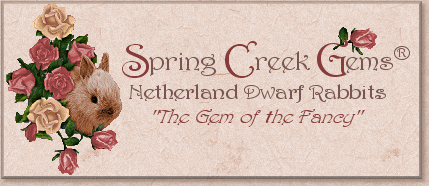ARTICLES
8.5.07
Babies
Breeding
Color Breeding
Feeding
Glossary
Grooming
History
Illustrated Pedigrees
Misc
Nestbox
Netherland Dwarfs
Problems
Rabbitry
Shows
The Rabbitry
Training
Winner's Circle
Links to More Info
|
NETHERLAND DWARFS

Due to copyrights, I can only give general, paraphrased info. Please visit ARBA to obtain a copy of the Standard Of Perfection for the detailed description of the breed.
The Netherland Dwarf (ND) is the smallest breed of rabbit. They can weigh anywhere between 1 1/2 lbs to 3 lbs at maturity. Preferred is between 2 - 2 1/2 lbs. They must be no more than 2 1/2 lbs (2.08 oz) to be shown. They are also one of the cutest breeds as they will look like baby bunnies all of their lives. Small ears, sweet round faces, and short round bodies are the signature of the ND. This is due to the dwarfing gene. See Dwarf Gene in the Glossary for more about how this works.
NDs are recognized in more varieties (37) than any other breed. Brokens which can be shown in any recognized variety bump this number up by double. These varieties are judged by themselves, and then in their Group, and finally against the entire breed. They are usually judged in this order.
Self Group (solid)
..... Ruby-Eyed White (REW) ~ True Albino. Pure white w/ pink eyes.
..... Blue-Eyed White (BEW) ~ Pure white w/ blue eyes.
..... Black ~ Pure black w/ brown eyes.
..... Chocolate ~ Rich brown w/ brown eyes.
..... Blue ~ Deep blue gray w/ blue-gray eyes.
..... Lilac ~ Light dove gray w/ blue-gray eyes. Lilac is the dilute of Chocolate, and will have a slight choc cast that makes it appear pinkish.
Shaded Group (points darker than body)
..... Siamese Sable ~ Rich sepia brown w/ darker points and brown eyes.
..... Siamese Smoke Pearl ~ Pearly gray w/ darker points and blue-gray eyes.
..... Sable Point ~ Creamy w/ sepia brown points and brown eyes.
..... Tortoise Shell ~ Rusty orange w/ black-gray points and brown eyes.
Agouti Group (banded and tipped hair shaft w/ white tan pattern markings)
..... Chestnut ~ Rich yellow brown w/ black ticking and brown eyes.
..... Chinchilla ~ White and gray w/ black ticking and brown eyes.
..... Squirrel ~ White and blue w/ blue ticking and blue-gray eyes.
..... Lynx ~ Lilac and fawn w/ fawn ticking and blue-gray eyes.
..... Opal ~ Blue and fawn w/ fawn ticking and blue-gray eyes.
Tan Pattern Group (white or tan markings on belly, under tail, face, ears, feet, around eyes, nape of neck, ticking on lower body)
..... Silver Marten ~ Solid w/ white markings. Black, Chocolate, Blue, Lilac shown against each other and eyes to match color.
..... Sable Marten ~ Siamese Sable w/ white markings and brown eyes.
..... Smoke Pearl Marten ~ Siamese Smoke Pearl w/ white markings and blue-gray eyes.
..... Otter ~ Solid w/ white and tan markings. Black, Chocolate, Blue, Lilac shown against each other and eyes to match color.
..... Tan ~ Solid w/ rich tan markings. Black, Chocolate, Blue, Lilac shown against each other and eyes to match color.
AOV Group (Any Other Variety)
..... Himalayan (Himi) ~ Pure white w/ colored points and ruby eyes. Black, Chocolate, Blue, Lilac shown against each other.
..... Orange ~ Bright orange w/ white tan pattern markings and brown eyes.
..... Fawn ~ Light creamy orange w/ white tan pattern markings and blue-gray eyes
..... Steel ~ Solid black or dark brown w/ gold ticking and brown eyes.
..... Broken ~ Any recognized variety w/ white broken pattern. Can be either blanket pattern (heavy color over back), or spot pattern (spinal stripe and side spots). Head markings required are nose (butterfly or mustach), eyes and ears. See Color Breeding for representives of the patterns.
There is also a multitude of unrecognized varieties that can occur. Knowing how color works in rabbits will help to avoid too many unshowable bunnies in the nestbox. Some of these wrong colors are useful with recognized varieties, and one needs to understand that as well.
Judging order for each variety is separated by age and sex. ND is a "4 Class" breed. There are 4 age/sex classes judged in this order.
..... Sr Buck Over 6 months of age, 2 - 2 1/2 lbs.
..... Sr Doe Over 6 months of age, 2 - 2 1/2 lbs.
..... Jr Buck Under 6 months of age, 1 - 2 lbs.
..... Jr Doe Under 6 months of age, 1 - 2 lbs.
The judging order would go like this:
..... Siamese Sable Sr Buck
..... Siamese Sable Sr Doe
..... Siamese Sable Jr Buck
..... Siamese Sable Jr Doe
Each age/sex class would be placed. Then the best of each sex would be chosen BOV/BOSV for that variety. If there isn't enough rabbits to fill the classes, the best of what is available will be chosen. The rabbits would stay up to be judged against the Group. In the above case, the Group is Shaded. If chosen BOG/BOSG, the rabbits would stay up to be judged against the breed. At that point, it could be chosen BOB/BOSB. BOB would then go to the Best In Show table to be judged against all other breeds.
NDs are a challenging breed to perfect, but with all the colors available, they are also one of the most fun. Their small size allows for more space in the rabbitry to work on them. NDs generally only have 2-4 kits per litter, although 5-7 is not uncommon. They are not easy breeders. There are often more failures than success in the nestboxes. While often frustrating, this means that you won't be overrun with baby bunnies.
Related Info: Glossary ; Color Breeding ; Training ; Shows ; Problems
|


